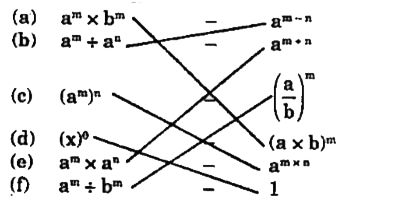(1000)0=10n then the value of n is –. Solution in Punjabi
Step by step video & image solution for (1000)^(0)=10^(n) then the value of n is ul. by Maths experts to help you in doubts & scoring excellent marks in Class 7 exams.
Updated on:21/07/2023Topper's Solved these Questions
- EXPONENTS AND POWERS BOOK - NAND LAL PUBLICATIONCHAPTER - EXPONENTS AND POWERS EXERCISE - ADDITIONAL QUESTIONS FOR PRACTICE (OBJECTIVE TYPE QUESTIONS) STATE WHETHER TRUE OR FALSE
6 Videos
- EXPONENTS AND POWERS BOOK - NAND LAL PUBLICATIONCHAPTER - EXPONENTS AND POWERS EXERCISE - ADDITIONAL QUESTIONS FOR PRACTICE (OBJECTIVE TYPE QUESTIONS)
1 Videos
- EXPONENTS AND POWERS BOOK - NAND LAL PUBLICATIONCHAPTER - EXPONENTS AND POWERS EXERCISE - EXERCISE 13.3
25 Videos
- ALGEBRAIC EXPRESSIONS BOOK - NAND LAL PUBLICATIONCHAPTER - ALGEBRAIC EXPRESSIONS EXERCISE - SAMPLE PAPER FOR PRACTICE
10 Videos
- FRACTIONS AND DECIMALS BOOK - NAND LAL PUBLICATIONCHAPTER - FRACTIONS AND DECIMALS EXERCISE - SAMPLE PAPER FOR PRACTICE
5 Videos
Similar Questions
Scientific notation for 0.00123 is
View SolutionMatch the following

View SolutionWrite the following numbers in expanded forms :
279404
View SolutionMatch the following

View SolutionIf 23 of a number is 24. Then what is 1.75 times of that number
View SolutionResult 1 If V0 is the value of an article at a certain time and R% per annum is the rate of depreciation then the value Vn at the end of n years is given by Vn=V0(1−R1000)n
View SolutionThe minimum value of n such that 1+3+32+........+3n≥1000
View SolutionIf m and n are whole numbers such that mn=121, then the value of (m−1)n+1 is a. 1 b. 10 c. 1000 d. 121
View SolutionThe value of 10∑n=0in equals
View SolutionLet f(n)=[14+n1000], where [x] denote the integral part of x. Then the value of 1000∑n=1f(n) is
View SolutionIf m and n are integers then is n completely divisible by 10?
A. The value of (m10+n10) is a integer value.
B. The value of (m7+n10) is an integer value.
C. value of n is greater than m.
View SolutionN/1000NaOH विलयन का pH मान ज्ञात कीजिए ।
View Solution.nPr=∣n––∣n−r–––––––.∣r–– होता है |
View Solution.nCr=∣n––∣n−r–––––––, जहाँ 0≤r≤n
View Solutionस्तम्भ 'अ'स्तम्भ 'ब'(i)n(n−1)(n−2)....3, 2, 1(a).nCr(ii)∣n–––∣n−r–––––––(b)∣r––(iii).nCr+.nCr−1(c)∣n––(iv)∣n–––∣n−r–––––––∣r–––(d).nPr(v).nPr/.nCr(e).n+1Cr
View SolutionLet an10nn! for 0≤n≤1 then the minimum value of n!(1−n)! is attained when a value of n=
View Solution
